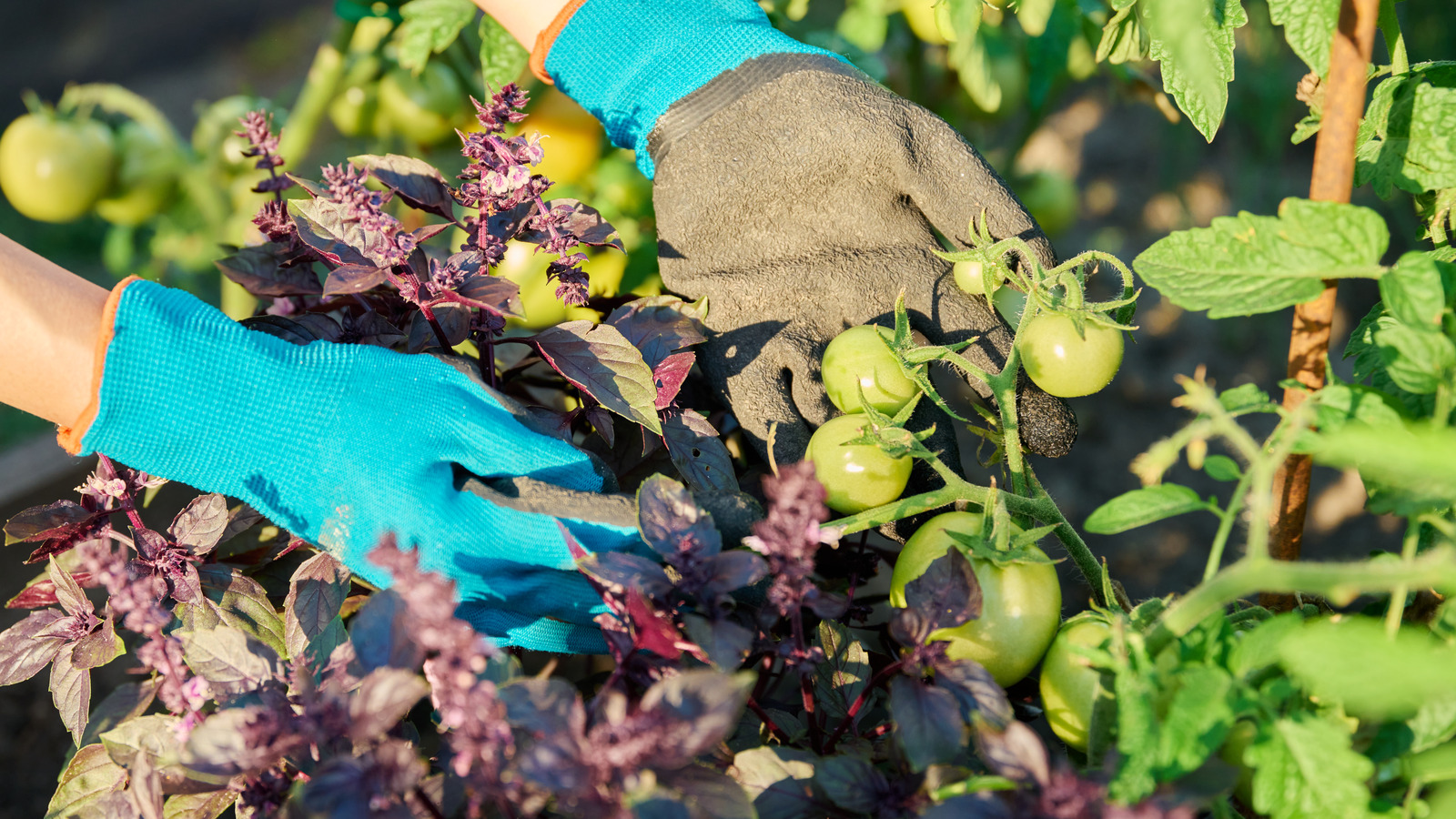We may receive a commission on purchases made from links.
The humble tomato is truly delicious. Whether you enjoy it sprinkled with a little sugar, upgraded with a dash of MSG, or as a key ingredient in salsa, nothing says “summer” like a ripe and juicy tomato. And double-nothing says summer like bringing a fresh tomato straight from the garden. But as humble and delicious as it may be, the tomato is not without problems. From pests to root rot to other issues, these juicy fruits need TLC, but it turns out that other plants can help tomatoes grow.
“As far back in time as anyone can remember, companion planting has been practiced,” says John Coykendall, master gardener at Blackberry Farm. “It was learned early on that certain plants thrived when planted together, and others had adverse effects on each other. An early example of companion planting was growing corn, beans, and squash together.” This is because companion plants help one another stay healthy in multiple ways.
As James S. Mastaler, founder & CEO of Pistils & Pollen, explains, “Companion planting helps build plant diversity into garden spaces, which in turn fosters a more balanced and resilient ecosystem. A mix of species can support pollinators, attract beneficial insects, and reduce pest pressure without chemical inputs.”
In order to successfully companion plant, you need to use the right species, and you need to do it in the right way. Accordingly, here are 15 of the best plants to grow alongside your tomatoes, with advice about how best to do it, straight from the experts.
1. Alyssum
Interplanting, or companion planting, is one of the best vegetable gardening tips for beginners, and nowhere is this truer than in the case of tomato and alyssum. It’s almost too easy. “Sweet alyssum is a versatile and beneficial companion plant that supports a healthy, productive garden,” says Sara Rubens, certified garden coach and founder of Seed to Sanctuary. “Its small, nectar-rich flowers attract beneficial insects like hoverflies, ladybugs, and lacewings, which help control aphids and other pests. It also draws in pollinators such as bees, boosting yields in crops like tomatoes, squash, and strawberries.”
Alyssum helps to protect the tomatoes at the soil level as well. Because it is low-growing, it also acts as living mulch, Sara Rubens says. It outcompetes weeds, conserves moisture, and keeps soil warm or cool as needed. As it grows quickly from seed, such as Back to the Roots 100% Organic Alyssum Seed Packet, you don’t have to wait long for its benefits. Plus, she adds, “Its soft blooms and sweet scent enhance the garden’s beauty.”
2. Basil
There are good reasons to plant basil and tomato together. “Basil is the ultimate tomato companion. Basil repels insects like mosquitoes and aphids,” Eduard Negodenko, landscaping expert and gardener of Avanti Landscaping. It can also help deter tomato hornworms. “Gardeners report that tomatoes grown near basil taste sweeter and have more vibrant colors, likely due to the improved plant health and pest reduction. Basil also thrives in the same conditions as tomatoes — full sun, well-drained soil, and moderate water — so it’s easy to care for them.”
Basil is a productive partner for tomatoes, James S. Mastaler says, because “It doesn’t compete much below ground, thrives in similar conditions, and its flowers attract pollinators and predatory wasps later in the season. I like tucking it at the base of my tomato plants in containers or raised beds.” This combo may be easy to remember as basil and tomato complement one another in dishes as well, especially when paired with fresh mozzarella. Try Home Grown Genovese Basil Seeds or plants from the garden center.
Since both basil and tomatoes like morning beverage leftovers, this companion planting duo is happy to have you repurpose tea bags or used coffee grounds as fertilizer. Basil enjoys both tea and coffee as a form of nourishment, while tomatoes benefit from coffee grounds, but only when added to compost first.
Tea bags are good for plants in general, but again, composting them first is a good idea.
3. Nasturtium
Not only are nasturtiums beautiful, coming in a range of colors from light gold to deep burgundy, but they are a perfect accompaniment to tomatoes. “Their blooms are tempting to parasitic wasps, which later, can hostage tomato bugs like aphids and inject eggs into them,” says Melvin Cubian, a plant care expert of PlantIn. “They also serve as a deterrent to these tiny critters, keeping your plant protected.”
Nasturtiums are easy to plant from seed. You can choose specific colors or a mix, such as the Seed Needs Nasturtium Seeds Jewel Mix. Also, Eduard Negodenko says, “They grow fast and spread, providing ground cover that suppresses weeds and keeps soil temperatures moderate.” Add in the fact that their flowers attract bees and butterflies while discouraging squash bugs and cucumber beetles that can harm other garden plants, and it’s a perfect mix.
4. Zinnia
Some of the best companion plants for tomatoes are also some of the prettiest. Zinnias are bright, cheerful, and highly aesthetic. “Their bright, long-lasting blooms attract a wide range of pollinators, including bees and butterflies, which help improve fruit and vegetable yields,” Sara Rubens says. “Zinnias are also known to lure beneficial predatory insects such as ladybugs and lacewings, which feed on pests like aphids and whiteflies.”
Zinnias are effective at controlling the pests attracted to cucumbers and squash. Moreover, Rubens says, “Zinnias add vibrant color and visual interest, making the garden more inviting and enjoyable. They’re easy to grow, thrive in full sun, and bloom continuously, offering extended support to both plants and pollinators throughout the season.” Zinnias are reliable seeders, so you’re fine buying a packet of seeds online, such as NatureZ Edge Zinnia Seeds. If you’re impatient, though, you can feel free to buy them from the garden center.
5. Garlic
It’s perhaps unsurprising, given garlic’s strong scent and flavor, that it can serve double duty as a pest deterrent. “Its strong sulfur compounds mask the scent of tomatoes, confusing pests like spider mites, aphids, and even Japanese beetles,” says Eduard Negodenko, “Garlic’s antifungal properties help suppress soil-borne diseases like powdery mildew and blight, which often afflict tomatoes.”
According to some experts, the pest-fighting effects are somewhat anecdotal, but large studies have definitely confirmed that garlic helps tomatoes grow more healthfully. “In a large-scale experiment conducted by agricultural scientists in China, intercropping rows of garlic between tomatoes improved the availability of phosphorus,” Melvin Cubian says. “This means that your tomato plants are able to absorb more phosphorus efficiently, and that means less fertilizer losses.” If you want to see these effects up close, you can get Fresh California Softneck Garlic Bulbs, but you can also just buy garlic heads at the store and plant individual cloves.
6. Thyme
“A low-growing, sun-loving herb, thyme makes an excellent living mulch at the base of tomato plants,” James S. Mastaler says. “It suppresses weeds, conserves moisture, and its tiny blooms attract hoverflies, whose larvae are natural aphid predators. It’s also a beautiful and aromatic addition to a tomato bed.”
There are many types of thyme, from woolly to lemon to Old English. An English Thyme Seed Packet will cover several square feet if you want to create a carpet of this beautiful herb, which will weather the winter well in most climates. In areas that see extreme cold, you can put them in pots and bring them indoors.
7. French marigold
Marigolds are a beautiful and useful addition to plant near tomatoes. “Certain varieties, particularly French marigolds, produce compounds that repel nematodes in the soil, while their scent helps keep aphids, whiteflies, and even some beetles at bay,” Sara Rubens says. “Marigolds also attract beneficial insects like ladybugs and hoverflies, which prey on garden pests, as well as pollinators that boost crop yields.”
Marigolds offer form as well as function, however. Their densely packed flower heads are bright and beautiful, blooming from early summer all the way to the frost in colors of gold, orange, red, and variegated patterns. If you want an especially vibrant effect, buy a mix such as The Old Farmer’s Almanac Petite Mixture Marigold Seeds.
8. Mint
Sweet, spicy, floral mint is pleasant in a wide array of foods, drinks, and desserts, but it has a beneficial role to play in your tomato patch, too. “One main advantage of mint, aside from its ease of handling, is that it has pest-antagonistic properties, which benefits the star of your garden, tomatoes,” Melvin Cubian says. “After planting, your only problem is how to make use of its profusely growing leaves!” Luckily, mint adapts well to constant trimming and hacking, so you can feel free to harvest it as often as you like.
If you’re an experienced gardener, though, you already know that mint needs a little rough handling; otherwise, it quickly gets out of control. The best approach is to plant mint in pots and place those near your tomatoes, then watch for and remove runners that try to establish in the soil. Mint is easily planted from seed; try Home Grown Premium Common Mint Seeds or Home Grown Peppermint Seeds for an extra-cool twist.
9. Parsley
If you think of parsley as a produce suitable only for sprinkling over finished dishes, think again. This member of the carrot family is among the best to plant with tomatoes, protecting them from what Melvin Cubian calls “ruthless herbivorous insects.” (Raise your hand if you now feel a little frightened to go out into the garden.) Luckily, the strong odor of parsley is unappealing to such pests and will help keep them away from your tomatoes, he says.
For the best effect, let parsley flower. Those flowers attract hoverflies, which feed on aphids. As aphids themselves like parsley, it can also serve as a trap crop: one that lures problem insects away from your real concern, tomatoes. Parsley grows easily from seeds, so you can feel free to experiment with a low-cost option such as Sow Right Flat Leaf Parsley Seeds. If that doesn’t work, you can always buy starters.
10. Calendula
“Easy to grow and loved by pollinators, calendula adds color and function,” James S. Mastaler says. “Its sticky blooms can trap aphids and thrips, and its presence in the garden increases overall floral diversity. I often interplant it among veggies to ensure a steady flow of nectar sources.”
Among calendula’s best characteristics are its mild antifungal properties, aromatic oils that repel tomato hornworms, and its ability to attract beneficial predatory insects. “Calendula’s bright, daisy-like flowers are long-blooming and provide a steady food source for these allies,” Eduard Negodenko says.
While traditional calendula flowers are golden-orange or orange, they actually come in a wide range of hues: pink, red, white, salmon, and more dramatic varieties. If you’re happy with orange and yellow and want a simple solution, Back to the Roots 100% Organic Calendula ‘Pacific Beauty’ Seeds will do the trick.
11. Chives
Chives are a common enough garden plant to which most people don’t ascribe enough power. Simply put, they’re more than a good baked potato or chili topping; they’re one of the best species to plant with your tomatoes.
“Chives are a compact herb with a mild onion scent that repels aphids, spider mites, and other soft-bodied insects that can decimate tomato foliage,” Eduard Negodenko says. “They require minimal space and can be planted in the same containers or beds as tomatoes without competition. Their purple flowers also attract pollinators, which can improve fruit set in tomatoes.” In many climates, moreover, chives are perennial, so you needn’t do anything for them to return year after year.
You can buy chives at the garden shop or as part of a mixed assortment of Sereniseed Certified Organic Herb Seeds. If you want to expand your horizons, try a Garlic Chives Seed Packet, a variation that brings some extra-garlicky flavor to the table.
12. Dill
Home cooks and gardeners don’t need an extra reason to grow dill. Its light, fresh, sweet, floral leaves make dill the perfect culinary addition to fresh green salads, potatoes, meat, pickled veggies, and even drinks. However, if you’re looking for an additional motivator to pick up a packet of Home Grown Dill Seeds, let it be this: Dill is one of the best species to plant near tomatoes.
“Dill brings in bees as well as predatory insects such as ladybugs and lacewings that help control harmful pests,” Sara Rubens says. However, you should note that there’s an age cap on the tomato-dill marriage. Once dill starts producing seeds, it uses soil nutrients that tomatoes need to thrive. So while you can absolutely plant young dill nearby, you should remove it once the plant bolts.
13. Borage
Red and blue is such a pretty combo, especially at the height of summer, and it is exactly this pleasing palette that tomatoes and borage offer when you plant them together. “Borage is a star companion plant that many gardeners overlook,” Eduard Negodenko says. “It attracts pollinators like bees and beneficial predatory insects like parasitic wasps and hoverflies, which help control aphid populations.”
Plus, he adds, borage has edible, cucumber-flavored flowers, which are a lovely addition to salads, desserts, or drinks. “Also, borage is believed to improve soil health by accumulating trace minerals like potassium and calcium, which benefit nearby tomatoes,” Negodenko adds. “Its hairy leaves deter some pests and discourage tomato hornworms.” There’s pretty much no reason not to grab a packet of Sow Right Non-GMO Heirloom Borage Seeds and include it in your garden next spring.
14. Sage
“Sage is a valuable companion plant known for its strong scent and pest-repelling properties,” Sara Rubens says. “Its aromatic oils help deter common garden pests such as cabbage moths, carrot flies, and beetles, making it especially useful when planted near crops like cabbage, carrots, and beans.” However, as it attracts both bees and predatory wasps when it blooms, it can be one of the best species to plant near tomatoes as well, helping promote tomato pollination as well as insect control.
Even better, sage is a very chill plant. “While it prefers well-drained soil and full sun, sage is relatively low-maintenance and can thrive alongside a variety of plants,” Rubens says. “Its compact growth habit makes it easy to tuck into garden beds without crowding neighboring crops.” Add to that its delicious scent and savory flavor, which make it an indispensable cooking tool, and sage becomes a no-brainer. You can either sow an option such as Home Grown White Sage Seeds directly or buy sage starters at the nursery in spring or fall, when they are often discounted.
15. Lavender
Like many of the plants in this list, lavender helps to repel whiteflies and spider mites. Its blooms also attract beneficial pollinators. Lavender, planted near tomatoes, won’t compete for water resources (as it doesn’t need much), and stays lower to the ground than tomatoes, so they don’t compete for light, either.
However, James S. Mastaler reminds us, “The best companion planting is about designing for ecological resilience, not just proximity. By prioritizing plant diversity — different flower shapes, root depths, bloom times, and habitats — we invite a greater range of insects and build a healthier system overall.” Lavender, with its compatible traits, can be a healthy part of that overall ecosystem. The goal, Mastaler says, is “thinking in terms of a ‘plant community’ rather than pairings can lead to stronger plants and a more vibrant garden.”
While seeds are sometimes cheaper, they are not always the easiest way to grow herbs, flowers, or other plants. Lavender is finicky about germinating, but is so easy to buy as a starter that it’s hard to justify bothering with seeds. If you don’t have a convenient nursery nearby, you can find fruit and vegetable plants online readily, and the same is true of herbs as well.
Common companion planting mistakes
Companion planting is a great way to make better use of your garden space and keep your plants healthier, including tomatoes. However, the concept is not carte blanche to interplant whatever you want; there are rules. “One common mistake is overestimating the magical benefits of certain combinations,” James S. Mastaler says. “While companion planting can be helpful, no pairing will replace good soil prep, proper spacing, and attentive care.” Overcrowding is another common pitfall, he warns. If you surround your tomatoes with too many companions, you might encourage fungus, “especially later in the season when plants are at their largest and humidity tends to peak.”
Moreover, not all veggies play nicely with tomatoes. Mastaler advises that corn and potatoes are heavy feeders and shouldn’t be planted where they can compete. According to John Coykendall, fennel, brassica, and black walnut are ill-advised species to plant near tomatoes.
Another important rule, Melvin Cubian adds, is not to put plants from the same family together. “Sharing almost the same genetics, this makes them an easy target to pests and diseases such as bacterial wilt and fruitworms,” he says. “If this happens, pest damage can literally occur in one night. Also, both plants demand a high amount of potassium and phosphorus. This means that both can compete with each other if the soil is not that fertile.” Stick to non-competitive, non-problematic species like the ones listed above, and you (and your tomatoes) will be just fine.





